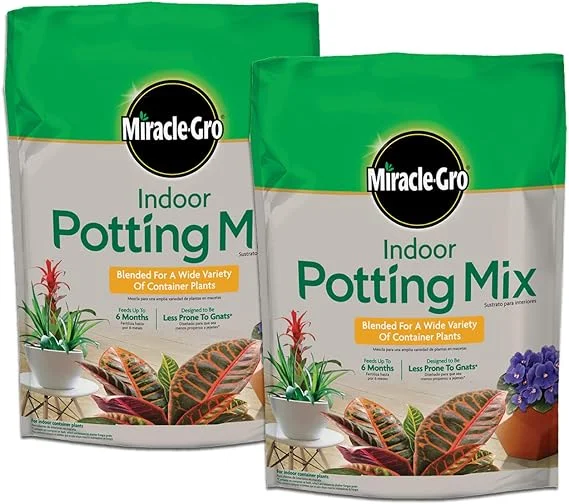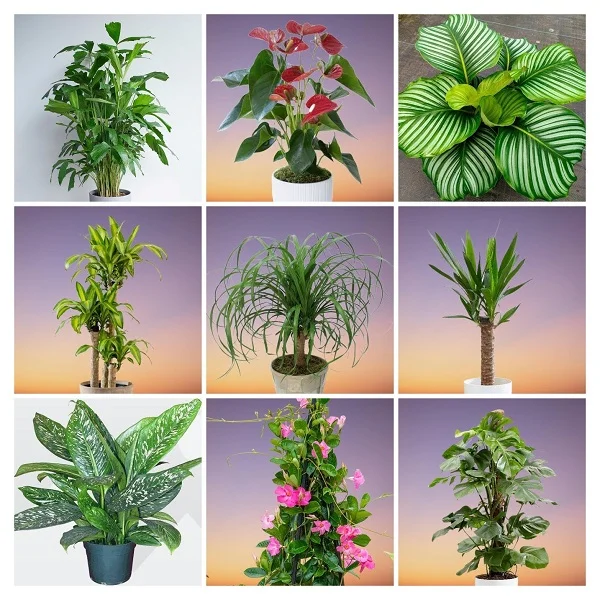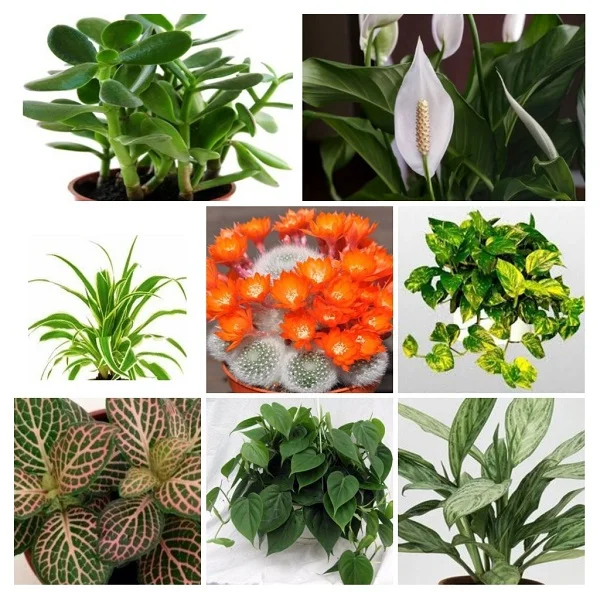How to Grow and Care for Foxtail Fern (Asparagus densiflorus 'Meyeri') Indoors
Some links in this post may be affiliate links
Foxtail Fern (Asparagus densiflorus 'Meyeri') grows best in medium to bright indirect light, average warmth, moderate humidity and moderately moist, rich, well-drained soils coupled with weekly feeding in the growing period.
If you want a lush, elegant, and easy-care houseplant, the Foxtail Fern is a top contender. This guide will walk you through everything you need to know about growing and maintaining a healthy and lush Foxtail Fern in your home.
Asparagus densiflorus 'Meyeri' also called Plume Asparagus is among the popular ornamental Asparagus ferns mainly grown for the beautiful foliage and texture.
Plume Asparagus is an evergreen fern-like plant whose erect stems are densely packed with needle-like foliage. The evergreen foliage grows in clumps giving the plant a spiky appearance. The 'leaves' are really needle-like branches.
The foxtail fern has an extensive root system with large tubers that can store water and food making it quite drought-tolerant.
Though commonly called a Fern, Foxtail Fern is not among the True Ferns, it is much easier to grow than true ferns.
Plume Asparagus adapts well to wide variations in light, heat and frequency of watering. It is one of the best low-light plants for dark spaces.
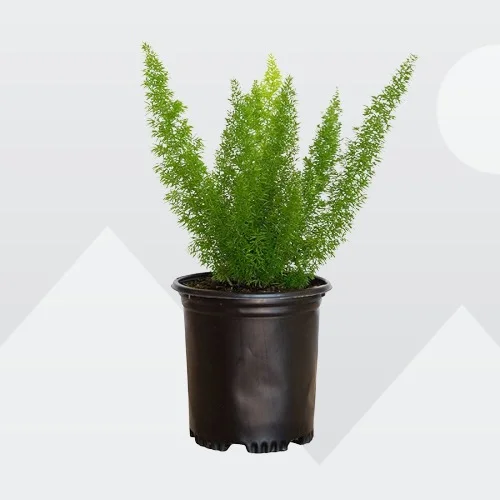
Botanical name: Asparagus densiflorus 'Meyeri'
Synonym: Asparagus densiflorus 'Myersii'
Family: Asparagaceae
Sufamily: Asparagoideae
Common names: Foxtail Fern, Plume Asparagus
Origin
Asparagus densiflorus 'Meyeri' is native to southern Africa from Mozambique to South Africa.
Size (height and width)
Foxtail Fern can grow to a height of 2 feet and 4 feet wide. Under ideal growing conditions, it grows at a medium rate, and can live for approximately 15 years.
Flower
When provided with the right growing conditions, Plume Asparagus may produce small white flowers which are followed by bright red berries.
Invasiveness
According to Mark Tancig (University of Florida), Asparagus Ferns have been found to be invasive. Avoid growing Asparagus Ferns in the ground and dispose them by burning as they grow vigorously, spreading across and scrambling up other plants.
Is Foxtail Fern poisonous?
Yes. Foxtail Fern like other Asparagus Ferns is toxic to humans and pets as indicated by ASPCA. If the berries are ingested, they can cause vomiting, diarrhea and abdominal pain. If handled with bare hands, they can cause contact dermatitis.
The foliage of mature plants can develop sharp spines on the branches which can cause skin irritation if handled with bare hands. Therefore, always wear gloves when handling the plant.
Where to Buy
If you are looking to add Asparagus Fern to your collection, you may get them online from Etsy (Link to Etsy) or from Amazon (Link to Amazon).
Asparagus densiflorus Meyeri Care Indoors
To care for Foxtail Fern indoors provide medium to bright indirect light, average warmth of 16-280C, moderate humidity of 50-55% and moderately moist, rich, well-drained soil coupled with weekly feeding during the growing season.
Asparagus densiflorus Meyeri care requires frequent pruning to keep it neat as well as discourage pest and disease infestations. Repotting is needed only when it becomes root-bound. Keep reading for more on these growing conditions and how to achieve them.
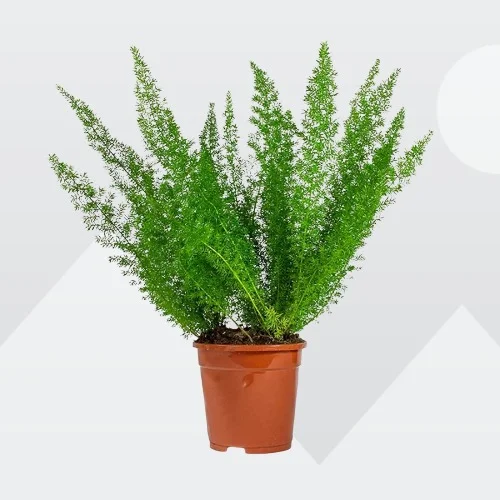
Watering
How do you water a Foxtail Fern?
Water Foxtail Fern thoroughly in spring and summer while allowing the top 2-3 inches of soil to dry a little between waterings. Avoid overwatering to prevent yellowing and browning.
Decrease watering in fall and winter as growth is reduced at this time. Do not let the soil dry out completely to avoid wilting and browning.
To ensure that the soilball is thoroughly wetted, occasionally water the Plume Asparagus from the bottom.
Use room temperature that is free of chlorine and other dissolved chemicals to avoid brown leaf tips and edges.
Ascertain that the pot has a drainage hole to prevent the soil from getting soggy as it can lead to root-rot and eventual death of the fern.
Light Requirements
Do Foxtail Ferns like sun or shade?
Foxtail Fern thrives in medium to bright indirect light (dappled light). Keep it away from direct sunlight as it can lead to scorching causing browning and leaf drop.
Though Asparagus densiflorus Meyeri can adapt to lower light conditions, too little light will cause the leaves to loss their color and turn yellowish. Therefore, where the natural lighting is not sufficient, instal a grow light to supplement it.
Rotate the pot regularly to ensure that the fern receives light from all sides for an even growth to prevent lopsided growth.
Temperature and Humidity
Foxtail Fern flourishes in an average warmth of 16-280C; a room temperature that is comfortable for you is ideal for this plant.
Though it can adapt to a wide range of temperatures, constantly high or low temperatures can cause yellowing and dropping of leaves.
Asparagus densiflorus Meyeri has no need for extra humidity. Moderate humidity of 50-55% is perfect for this plant. Low humidity can result in brown leaf edges. Use a humidifier or a wet pebble tray to increase humidity. Make sure there is good airflow to minimize fungal diseases.
Feeding
What is the best fertilizer for Foxtail Fern?
Feed Foxtail Fern with a balanced, liquid fertilizer weekly during the growing season (spring and summer) for lush growth. Make sure to follow the instructions on the label.
Do not feed in the cold season (fall and winter) as growth is minimal and feeding at this time may cause fertilizer burn and death of the plant.
Every 1-2 months, flush out accumulated salts from the soil by running a stream of water through the soil until it drains through the drainage hole.
Potting soil
The best potting soil for Foxtail Fern is a well-draining potting mix that does not getting soggy while providing the required nutrients. A blend of peat moss for moisture retention, perlite or sand for drainage, and compost for added nutrients is ideal for this plant.
Repotting
How often should I repot my Foxtail Fern?
Repot Foxtail Fern every 1-2 years at the beginning of the growing season, only if it has become pot-bound, to provide adequate space for the growth of the tuberous roots.
Use a pot that is only 1 size larger than the current one. Ensure that the pot has a drainage hole to prevent the soil from getting soggy as it can lead to root-rot. Check out these ceramic pots with drainage holes on Amazon.
You may divide a large fern during repotting and pot the sections in individual pots to propagate new plants.
Pruning & Grooming
How to prune Foxtail Fern?
Pruning Foxtail Fern involves:
- Cutting back of the old stems to make room for new growth.
- Trimming the dead leaves and branches to keep the fern tidy as well as reduce pest and disease infestations.
Occasionally, rinse the plant under lukewarm water to refresh the leaves and to remove dust as it can hinder photosynthesis.
Foxtail Fern Propagation
Foxtail Fern (Asparagus densiflorus 'Meyeri') is propagated at the beginning of the growing season from seeds or by plant division. The easiest method of propagation is by plant division.
Learn how to propagate Foxtail Fern in 3 easy ways.
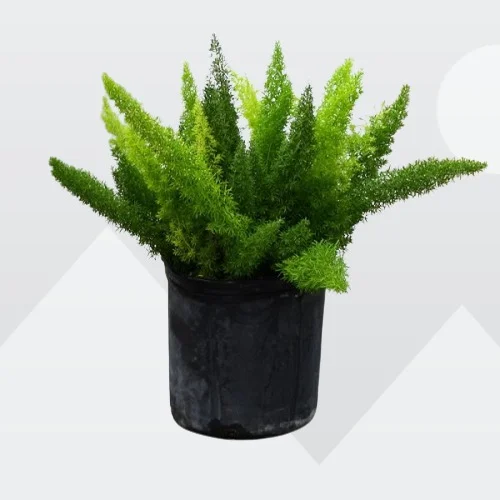
Foxtail Fern Problems & Remedies
Foxtail Fern (Asparagus densiflorus Meyeri) problems are yellowing and dropping leaves, plant dying, brown leaves, drooping leaves, brown leaf tips, leggy growth, pests and diseases among others. Read on for more on these problems and their solutions.
Yellowing and dropping leaves
Why are the leaves on my Foxtail Fern turning yellow and falling?
Yellowing and dropping leaves on Foxtail Fern is caused by too little light, inconsistent watering, soggy soil, drafts, nutrients deficiency, and direct sunlight.
How to fix it
Too little light: Position the plant in a brighter spot under bright indirect light or use a grow light.
Inconsistent watering: Water when the top 2-3 inches of soil dry out but do not allow the soil to dry out completely.
Soggy soil: Use a well-draining soil and a pot that has a drainage hole.
Drafts: Keep the fern away from drafts coming from AC units, heat sources, windy doors among others.
Nutrients deficiency: Feed the plant with a balanced, water-soluble fertilizer every week in spring and summer.
Direct sunlight: Place the plant away from direct sunlight or use a light curtain to filter the sunshine.
Check out these 12 Reasons Asparagus Fern Leaves are Yellowing and Dropping.
Plant dying
Why is my Foxtail Fern dying?
Your Foxtail Fern is dying due to root-rot which is promoted by soggy soil. The thick, tuberous roots will rot in soggy soil. Once the roots rot, the plant will certainly die if corrective measures are not taken in time.
How to fix it
- Carefully slip the fern out of its pot and inspect the roots.
- Trim the brown-black, mushy roots and treat the healthy roots with a copper-based fungicidal solution as per the instructions on the label.
- Disinfect the pot with the fungicidal solution or use a fresh pot to repot the plant in fresh, well-draining soil.
- Do not water the plant immediately and keep it dry for 5-7 days before you can resume watering.
- Use a pot with a drainage hole and well-draining soil to prevent the soil from getting soggy.
- Cut down on watering in fall and winter as growth is slowed at this time; keep the soil slightly moist.
Brown leaves
Why are the leaves on my Foxtail Ferns turning brown?
The main causes of brown leaves on your Foxtail Fern are inconsistent watering, temperature stress, direct sunlight, soggy soil and aging.
How to fix it
Inconsistent watering: Water when the top 2-3 inches of soil dry. Never allow the soil to dry out completely.
Temperature stress: Protect the plant from drafts emanating from AC units, heat sources, windy doors and others.
Direct sunlight: Keep the fern away from direct sunlight or use a sheer curtain to filter the sunshine.
Soggy soil: Use a pot with a drainage hole and well-draining soil.
Aging: This is a natural process; as the fern matures the lower leaves turn brown and begin to die.
Drooping leaves
Why is my Foxtail Fern drooping?
Your Foxtail Fern is drooping due to underwatering, extreme temperatures, dry air, direct sunlight, and soggy soil.
How to fix it
Underwatering: Water when the top 2-3 inches of soil feel dry. Never allow the soil to dry out completely.
Extreme temperatures: Keep the plant away from drafts emanating from AC units, heat sources, windy doors and others.
Dry air: To raise humidity, set the pot on a wet pebble tray, use a humidifier or group the plants together.
Direct sunlight: Keep the plant away from direct sunlight or use a sheer curtain to filter the sunshine.
Soggy soil: Make sure that the soil is well-draining and a pot that has a drainage hole.
Brown leaf tips
Brown leaf tips on Foxtail Fern are due to dry air, underwatering, and direct sunlight.
How to fix it
Dry air: Use a wet pebble tray or a humidifier to elevate humidity.
Underwatering: Water when the top 2-3 inches of soil dry and never allow the soil to dry out completely.
Direct sunlight: Keep the plant away from direct sunlight or use a light curtain to filter the sunlight.
Leggy growth
Leggy growth on Foxtail Fern is caused by lack of pruning, low light, and improper feeding.
How to make Asparagus Fern bushier?
Lack of pruning: Trim the leggy stems to encourage a bushier growth.
Low light: Position the fern near a large, brightly-lit window or use a grow light if you do not have sufficient light in your home.
Improper feeding: Both underfertilizing and overfertilizing can cause leggy growth. Therefore, feed the fern with a balanced, water-soluble fertilizer every week in spring and summer. Ensure to follow the manufacturers recommendations.
Pests
What are the pests of Foxtail Fern?
Common pests on Foxtail Fern are aphids, mealybugs, spider mites and whiteflies whose infestation is enhanced by either underwatering or dry air.
How to fix it
- Isolate the affected fern to prevent spread to the other plants.
- Treat the infested plant with neem oil or insecticidal soap as per the manufacturers instructions.
- Regularly check underneath the leaves for these pests and carry out timely control measures.
- Keep the plant properly pruned and increase humidity to discourage pest infestation.
Diseases
Foxtail Fern is prone to crown-rot and stem-rot which is prevalent in poorly ventilated and too wet conditions. The disease is characterized by softening and rotting of part of the stem or crown which spreads rapidly and kills the plant. The disease is difficult to treat.
How to fix it
- Seperate the affected fern and cut away and discard or burn the diseased parts to prevent spread to the other plants.
- Keep the soil on the drier side. Avoid soggy soil by ensuring that the soil is free-draining and the pot has a drainage hole.
- Improve ventilation to ensure that there is free air flow for the fern.
- If the plant is too far gone, discard or burn it. Discard its pot and soil to minimize spread to the rest of the plants.
Conclusion
Foxtail Fern (Asparagus densiflorus 'Meyeri') is a stunning, easy-care indoor plant that brings texture and greenery to any home. With its soft, feathery fronds and minimal maintenance needs, it is perfect for beginners and seasoned plant lovers alike. By providing bright light, moderate watering, and occasional pruning, your Foxtail Fern will thrive for years.
Frequently Asked Questions
1. Is the Foxtail Fern a true fern?
No. Despite its name, Foxtail Fern is actually part of the Asparagus family, making it hardier and easier to care for than true ferns.
2. Can I grow a Foxtail Fern in low light?
Yes, but the growth will be much slower and leggier. Bright, indirect light is best for Foxtail Fern.
3. Is the Foxtail Fern pet-friendly?
No. Foxtail Fern is toxic to cats and dogs if ingested. Keep it out of reach of pets.
4. How do I make my Foxtail Fern bushier?
To make your Foxtail Fern bushier, give it plenty of bright indirect light, feed it weekly with a balanced fertilizer in spring and summer and cutback the leggy stems to encourage new growth.
5. Can I grow a Foxtail Fern in a hanging basket?
Yes, you can grow Foxtail Fern in a hanging basket. Its trailing, bushy growth looks fantastic in hanging planters or elevated pots.
6. Can you divide a Foxtail Fern?
Yes. Divide your Foxtail Fern in spring to early summer to multiply your plants.
7. Can you propagate Foxtail Fern from cuttings?
No. Foxtail Fern is propagated by plant division or from seeds.
You liked it? Share on social media.
Related Content
Amazon Associates Disclosure
Homeplantsguide.com is a participant in the Amazon Services LLC Associates Program, an affiliate advertising program designed to provide a means for sites to earn advertising fees by advertising and linking to amazon.com.

